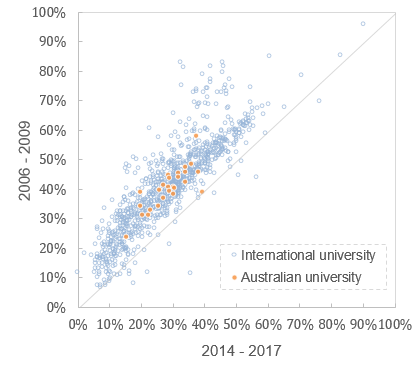The New CWTS Ranking for Open Access
The new OA indicators combine data from Web of Science and Unpaywall on four types of OA and an overall indicator for all forms of OA[1]. .
The four types of OA are:
- Gold. Publications in an open access journal.
- Hybrid. Publications in a subscription journal that are open access.
- Bronze. Publications in a journal that are open access without a license.
- Green. Publications in a journal that are also available in an open access repository.
The overall indicator shows that OA publishing grew between the periods of 2006-2009 and 2014 – 2017. For the 26 Australian universities listed in the CWTS rankings[2] the average proportion of OA publications has grown from 28.7% in 2006 - 2009 to 40.3% in 2014 – 2017 (Figure 1).
Over 2014 – 2017 an average of 32% of OA publications were Green, 13.3% Gold, 8.7% Bronze and 5.6% Hybrid across all universities. The sum of these figures (60.1%) is greater than the total proportion of OA publications (40.3%), suggesting that perhaps half of Australian OA publications are being made available via more than one OA model.

This graph shows the proportion (%) of publications counted as OA for the time period 2006-2009 compared with 2014-2017 for Australian universities (n = 26) vs all other international universities (n = 937). Those above the line have improved, those on the line have remained unchanged and those below the line have gone backwards.
